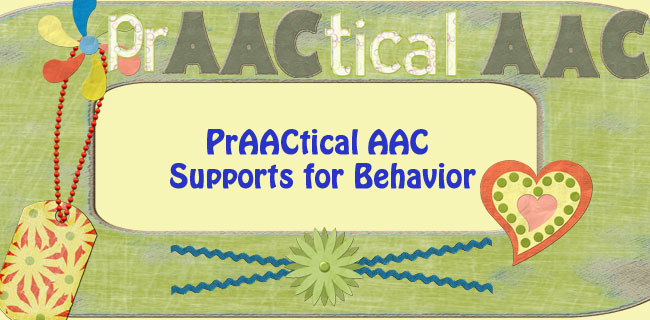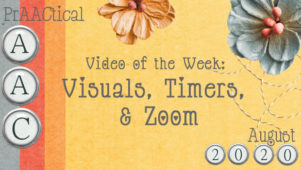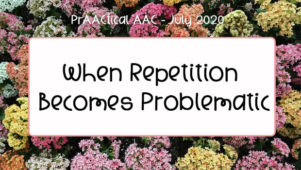PrAACtical AAC Supports for Behavior

 Our July Strategy of the Month, PrAActical AAC Supports for Behavior, is a favorite topic for us, because with a little planning, we can adhere to the old adage that an ‘ounce of prevention is worth a pound of cure’ (as Carole said last week). We also find that behavior challenges are often one of the main reasons, our students (and colleagues) get stressed about working with children with significant communication impairments. And since stress for ANYONE does not make for an optimal learning environment, we love to show how effective preventative strategies work.
Our July Strategy of the Month, PrAActical AAC Supports for Behavior, is a favorite topic for us, because with a little planning, we can adhere to the old adage that an ‘ounce of prevention is worth a pound of cure’ (as Carole said last week). We also find that behavior challenges are often one of the main reasons, our students (and colleagues) get stressed about working with children with significant communication impairments. And since stress for ANYONE does not make for an optimal learning environment, we love to show how effective preventative strategies work.
This week we are focusing on ‘setting the stage’ for conventional and appropriate behavior by engineering the physical environment. We are talking about more than keeping the room neat, clean, and generally organized. We are talking about arranging the physical environment in a planned and careful way in order can make a huge difference in helping a student to
- learn communication and language
- use AAC
- interact
- be independent
- participate
- use appropriate behavior
Getting Started
We begin by thinking about how the physical environment can help a student understand boundaries and limitations. We find ways to make sure the environment is clear and consistent because then we have an easy way to redirect in a positive manner if necessary (remember none of us are 100% perfect with our behavior). But, once a child knows the ‘process’, they usually need very few redirections. We sometimes call it the ‘power of the paper (tape, sign, etc)’. Most of the ideas we have found have been from a typical ‘good’ teaching practices or from a ‘behavioral challenge’ we have had with a student. We learned quickly if we ‘set the stage’ we saw less and less behavior challenges or….just maybe we had a physical environment that supported the student rather than hindered them…
What, Why, and How?
Labels
- Student Picture and Name Label– we label the therapy room door with a picture of the student(s), so the student can find their own room (even if it changes) and know where they belong. We might even have them ‘sign in’ on the door to build in a routine and process, which slows down running or rushing into the room.
- Shelves, Drawers, Boxes Labels– we use bins, drawers, boxes, and bags to store therapy materials. We label everything with a symbol that the child understands or is learning to understand and the written word. We do this so the student can clean up independently, check their schedule and find the bin, drawer etc, to go get their own materials. For a beginning communicator or a child with some fine or gross motor difficulties, we would use bigger bins and have even been known to use a party tub so no matter where the child dropped the materials, they landed in the appropriate place. For children with more physical limitations, the student can communicate to an adult what to get.
Signs
- Stop/Go Signs to let the student know when they can and can’t use materials, enter a room, go to an area. This was like a miracle for a teenager who often went into her siblings’ rooms without asking (they were teenagers too and not happy about it). Once the stop/go was used, she got it very quickly. We couldn’t believe it- when on day 3, mom called to say “When Amy saw me coming with her laundry, she ran ahead and turned the ‘go’ sign to ‘stop’, so she did not have to put her laundry away”.
- Open/Close Signs to let students know when different rooms are available or not available.
Area Boundaries
- Taped Areas so the student can know where they are allowed to play with certain toys/materials. This solved a huge throwing problem by one of our students. It was easy to redirect by saying, “balls stay in the ball area”. We knew he got it when he placed many balls right on the tape. This was acceptable for us, but not always for other clinicians who wanted the balls in the area and not touching the tape. The student quickly learned who expected what. We love that duct tape is popular and getting more visual.
- Nicer Physical Boundaries (not always possible in therapy rooms used by multiple clinicians), but we try to make the boundaries have as much meaning as possible. We might also use themed towels or sheets, car mats, we try to use natural but clear boundaries whenever possible.
Concluding Thoughts
-
Keep labels and signs at appropriate heights for size of student
-
Try and make physical boundary indicators and labels as relevant and authentic as possible (i.e, use race car tape for the car area)
-
Use ALL language facilitation strategies such as aided language input, expansions/extensions, scaffolding, & recasting
-
Don’t be surprised if you need to remind students more than once of some of the visual rules
-
Think of challenging behaviors as OPPORTUNITIES to develop new supports and to PRACTICE learning limitations and boundaries. We tell our graduate students all the time, that it does not matter if we are working on communicating for behavior or communicating for a specific language concept, both are valid and sometimes, understanding rules and boundaries is even a higher priority goal. It is all about teaching it.
Filed under: Strategy of the Month
Tagged With: behavior, behavior management, visual supports
This post was written by Robin Parker





